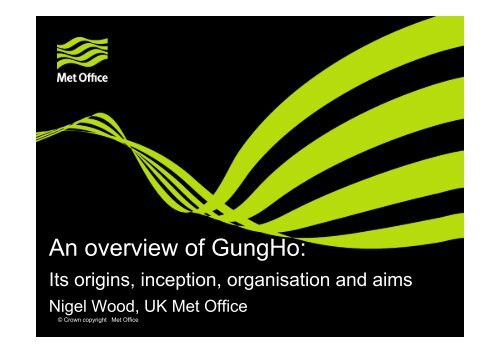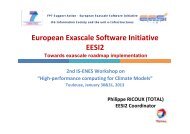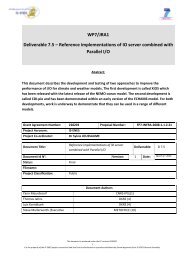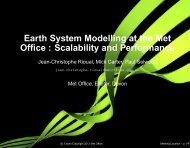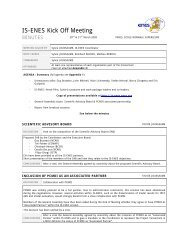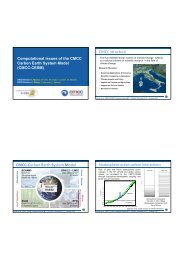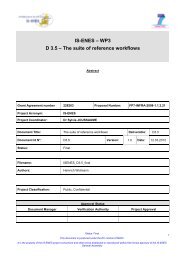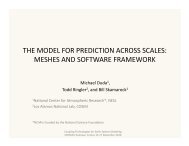An overview of the GUNG-HO project - IS-ENES
An overview of the GUNG-HO project - IS-ENES
An overview of the GUNG-HO project - IS-ENES
You also want an ePaper? Increase the reach of your titles
YUMPU automatically turns print PDFs into web optimized ePapers that Google loves.
<strong>An</strong> <strong>overview</strong> <strong>of</strong> GungHo:<br />
Its origins, inception, organisation and aims<br />
Nigel Wood, UK Met Office<br />
© Crown copyright Met Office
Outline<br />
• The Unified Model – where we are now<br />
• The need for change<br />
• GungHo!<br />
• Issues and progress<br />
© Crown copyright Met Office<br />
• Summary
Met Office’s Unified Model<br />
Unified Model (UM) in that t single model for:<br />
• Operational forecasts at<br />
‣Mesoscale (resolution approx. 12km → 4km → 1km)<br />
‣Global scale (resolution approx. 25km)<br />
• Global and regional climate predictions (resolution<br />
around 100km, run for 10-100 100 years)<br />
• Seasonal predictions<br />
• + Research mode (1km - 10m) and single column<br />
model<br />
• 21 years old this year<br />
© Crown copyright Met Office
Current Unified Model<br />
“New Dynamics”<br />
Davies et al. (2005)<br />
Dynamics:<br />
Physics:<br />
• Regular lat/lon grid.<br />
• Non-hydrostatic dynamics with a<br />
deep atmosphere.<br />
• Spectral band radiation<br />
• Diagnostic or prognostic cloud<br />
• Mixed-phase ppn<br />
• Semi-implicit time integration with<br />
3D semi-Lagrangian advection.<br />
• Atmospheric tracer advection • Boundary layer<br />
• Mass flux convection<br />
• Gravity wave schemes<br />
Coupling possible to non-atmospheric components:<br />
• Land surface model<br />
• Sea ice model<br />
• Ocean model<br />
• Chemistry/aerosol model …<br />
© Crown copyright Met Office
Operational NWP Models: Jun 2011<br />
Global<br />
‣25km 70L<br />
‣4DVAR – 60km<br />
‣60h forecast twice/day<br />
‣144h forecast twice/day<br />
‣+24member EPS at 60km 2x/day<br />
NAE<br />
‣12km 70L<br />
‣4DVAR – 24km<br />
‣60h forecast<br />
‣4 times per day<br />
‣+24member EPS at 18km 2x/day<br />
UK-V (& UK-4)<br />
‣1.5km 70L<br />
‣3DVAR (3 hourly)<br />
‣36h forecast<br />
‣4 times per day<br />
© Crown copyright Met Office
Relative performance<br />
RMS surface pressure error over <strong>the</strong> Nor<strong>the</strong>rn Hemisphere<br />
© Crown copyright Met Office
© Crown copyright Met Office<br />
Operational users 2011
© Crown copyright Met Office<br />
<strong>An</strong>d today’s wea<strong>the</strong>r…
The need for change…<br />
© Crown copyright Met Office
Super-typhoon Megi<br />
Stuart Webster<br />
• Made landfall in <strong>the</strong><br />
Phillipines on October 18 th<br />
2010<br />
• Lowest recorded central<br />
pressure for 20 years :–<br />
885hPa<br />
• Image to right captured by<br />
Terra satellite just prior to<br />
landfall<br />
• 1.5km nested simulation<br />
© Crown copyright Met Office
© Crown copyright Met Office<br />
Resolution, resolution, resolution…
N512 scalability – Cray XE6<br />
Sp peedup p<br />
9<br />
8<br />
7<br />
6<br />
5<br />
4<br />
3<br />
2<br />
1<br />
0<br />
0<br />
2000<br />
Ideal<br />
Cray XE6<br />
4000<br />
6000<br />
8000<br />
Cores<br />
10000<br />
12000<br />
• Climate model (atmosphere only)<br />
© Crown copyright Met Office<br />
14000<br />
• Preparation for real science on PRACE XE6<br />
Thanks to<br />
Pier-Luigi<br />
Vidale, NCAS
Scalability (March 2010)<br />
14<br />
12<br />
10<br />
8<br />
6<br />
N512L70 - no I/O<br />
N512L70 - full I/O<br />
UKV<br />
HadGEM3-AO<br />
4<br />
2<br />
0<br />
0 500 1000 1500 2000<br />
© Crown copyright Met Office
The finger <strong>of</strong> blame…<br />
• At 25km<br />
resolution,<br />
grid spacing<br />
near poles =<br />
75m<br />
• At 10km<br />
reduces to<br />
12m!<br />
© Crown copyright Met Office
Challenges!<br />
• Scalability – climate accelerating demand on model<br />
© Crown copyright Met Office
Challenges!<br />
• Scalability – climate accelerating demand on model<br />
• Speed – cannot sacrifice this for low resolution<br />
moderate core counts<br />
• Accuracy – need to maintain standing <strong>of</strong> model<br />
• Space wea<strong>the</strong>r ⇒ 600km deep model…<br />
• Danger:<br />
Everything to everyone…or<br />
Nothing to anyone<br />
© Crown copyright Met Office
GungHo!<br />
Globally<br />
Uniform<br />
Next<br />
Generation<br />
Highly<br />
Optimized<br />
© Crown copyright Met Office
5 Year Project<br />
• “To research, design and develop a new dynamical<br />
core suitable for operational, global and regional,<br />
wea<strong>the</strong>r and climate simulation on massively parallel<br />
computers <strong>of</strong> <strong>the</strong> size envisaged over <strong>the</strong> coming 20<br />
years.”<br />
• To address (inter alia):<br />
‣What should replace <strong>the</strong> lat-lon grid<br />
‣How to transport material on that grid<br />
‣Is implicit time scheme viable/desirable on such computers<br />
• Split into two phases:<br />
© Crown copyright Met Office<br />
‣2 years “research”<br />
‣3 years “development”
UK Collaboration <strong>of</strong> GFD,<br />
numerical and computational<br />
scientists<br />
• 5 FTEs from Met Office (Dynamics Research<br />
& HPC Optimisation)<br />
• 5 FTEs from NERC (Bath, Exeter, Imperial,<br />
Leeds, Manchester, Reading)<br />
• 2 FTEs from STFC<br />
© Crown copyright Met Office
© Crown copyright Met Office<br />
Working Toge<strong>the</strong>r Harmoniously
Organisation<br />
• Executive board<br />
‣Ned Garnett (NERC);<br />
‣<strong>An</strong>dy Brown (MetO);<br />
‣Mike Ashworth (STFC);<br />
‣Pier-Luigi Vidale (NERC/NCAS);<br />
‣Nils Wedi (ECMWF);<br />
‣Nigel Wood (MetO)<br />
• Regular one day focus meetings (IC)<br />
• Regular two day plenary meetings<br />
© Crown copyright Met Office
GungHo Themes: Phase 1<br />
• Quasi-Uniform Grids (icosahedral;<br />
kites/balanced triangles; cubed-sphere;<br />
Yin-Yang) Yang)<br />
• Advection schemes (conservation, SL, ...)<br />
• Time schemes (explicit vs. implicit)<br />
• Test cases<br />
• Computational science aspects<br />
© Crown copyright Met Office
GungHo Themes: Phase 2<br />
• Refinement & testing <strong>of</strong> Phase 1 proposal<br />
• Vertical aspects<br />
‣Choice <strong>of</strong> variables<br />
‣Grid & Staggering<br />
‣Discretization<br />
• Code development and testing<br />
© Crown copyright Met Office
Issues and progress…<br />
© Crown copyright Met Office
Quasi-Uniform Grids<br />
• Review <strong>of</strong> options and pros & cons<br />
‣QJ Q Review paper p on all things grid-like<br />
[Staniforth and Thuburn]<br />
• Fundamental research on finite<br />
difference non-orthogonal C-grid<br />
[Thuburn and Cotter]<br />
• Fundamental research for finite elements<br />
[Cotter]<br />
© Crown copyright Met Office
Quasi-Uniform Grids II<br />
• <strong>An</strong>alysis <strong>of</strong> emerging spectral element<br />
scheme highlights shortcomings <strong>of</strong><br />
scheme<br />
[Melvin, Staniforth, Thuburn]<br />
• Yin-Yang version <strong>of</strong> ENDGame Shallow-<br />
water model written (plus efficient<br />
solution <strong>of</strong> elliptic solver for overset<br />
grids)<br />
[Zerroukat]<br />
© Crown copyright Met Office
Transport Schemes<br />
• Work beginning to spin up<br />
• Inherent conservation <strong>of</strong> tracers = key<br />
driver<br />
• Is semi-Lagrangian scheme viable or<br />
desirable<br />
• Interaction with TRiSK scheme<br />
© Crown copyright Met Office
Time Schemes: Explicit<br />
• Split-explicit scheme ruled out – pros<br />
outweighed by cons<br />
• Multi-step schemes (e.g. leapfrog) ruled<br />
out due to efficiency and accuracy<br />
issues<br />
• ⇒ Multi-stage schemes (i.e. Runge-<br />
Kutta)<br />
© Crown copyright Met Office
Time Schemes: Explicit II<br />
• Vertical grid spacing makes explicit<br />
it<br />
scheme in vertical too expensive<br />
⇒ Horizontally Explicit Vertically Implicit<br />
• Work started on analysing such<br />
schemes to propose appropriate form<br />
[Lock, Smith, Staniforth, Thuburn, Wood]<br />
• Interaction with implicit work…<br />
© Crown copyright Met Office
Time Schemes: Implicit<br />
• Preferred approach (accuracy, stability)<br />
but scalability<br />
• Test problem defined and initial runs<br />
[Scheichl, Mueller, Allen, Pickles]<br />
• Easier to say no than yes…<br />
• …can we design a switchable scheme<br />
(HEVI makes this more likely)<br />
© Crown copyright Met Office
Test Cases<br />
• Collecting wide range <strong>of</strong> test cases<br />
[Weller, Staniforth, Thuburn]<br />
• Identify impact <strong>of</strong> computational modes<br />
(spatial/temporal)<br />
• Impact <strong>of</strong> excessive diffusion<br />
i<br />
© Crown copyright Met Office
Computational Science<br />
• Scientists embedded within each <strong>the</strong>me<br />
[Ford, Gross, Ham, Malcolm, Pickles,<br />
Riley, Selwood]<br />
• Pr<strong>of</strong>iling <strong>of</strong> any proposed approach<br />
• Key to future-pro<strong>of</strong> f proposal<br />
• Therefore design not linked to any<br />
specific architecture<br />
• Abstraction… ti [hear David Ham’s talk!]<br />
© Crown copyright Met Office
Summary…<br />
© Crown copyright Met Office
Continual Improvement…<br />
RMS surface pressure error over <strong>the</strong> NE Atlantic<br />
© Crown copyright Met Office
GungHo!<br />
Globally<br />
Uniform<br />
Next t<br />
Generation<br />
Highly<br />
Optimized<br />
© Crown copyright Met Office
Questions<br />
© Crown copyright Met Office
Super-typhoon Megi simulations (II).<br />
• Suite initialised using global analysis at 00z on 13/10/10<br />
• So about 120 hours before landfall<br />
• Observed central pressure at this time 1004 hPa.<br />
• Global l and 12 km simulations run for 6 days<br />
• Compared to 2 days previously<br />
• 4km and 1.5 km simulations both:-<br />
• initialised using T+6 flow fields <strong>of</strong> 12 km simulation.<br />
• Both use LBCs derived from 12 km model.<br />
© Crown copyright Met Office
12km, 4km and 1.5 km domains<br />
1.5km model<br />
2000 x 1000 x 70<br />
dt=10 s<br />
4km model<br />
750 x 380 x 70<br />
dt=30 s<br />
12km model<br />
400x200x70<br />
dt=60 s<br />
• Area shown is<br />
4800 km x 2400 km<br />
© Crown copyright Met Office
© Crown copyright Met Office<br />
Cyclone Tracks


